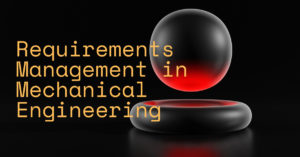
Mechanical engineering is a broad discipline that includes industries and technology ranging from aircraft and combustion to refrigeration and internal combustion engines.
Practical requirements management is a critical component of every successful mechanical engineering project. This entails gathering, recording, arranging, and tracking the many criteria that must be satisfied for a project to be effectively completed.
Requirements are classified into two types: functional and non-functional.
Functional requirements specify what a product or system should accomplish, whereas non-functional requirements specify how well it should do. Both sorts of criteria are crucial to the success of any mechanical engineering project and must be carefully handled to guarantee that the final product fulfils all required parameters.
A requirements management tool is one of the most critical instruments for efficient requirements management. These software tools simplify the requirements management (and project management) process, making it easier for mechanical engineers to track what has to be done and when.
Valispace is one of the most important and widely used requirements management solutions. It’s a cloud-based platform for mechanical engineers that allows them to organize requirements, engage with team members, and track progress in real-time. It is straightforward, making it the ideal tool for any mechanical engineering job.
The Process of Requirements Management
A fundamental component of every mechanical engineering project is the requirements management process. Gathering and documenting requirements is the first step in the process. Working with stakeholders to understand their wants and concerns and then generating a complete list of all the criteria that must be satisfied for the project to be successful is what this entails.
After gathering and documenting the requirements, they must be prioritized and structured. This entails evaluating which requirements are most crucial to the project’s success and which may be delayed till later. It also involves grouping similar requirements to manage and track them more efficiently.
Reviewing and approving requirements is the next stage in the requirements management process. This is usually done by a team of professional engineers ensuring that all requirements are correct, complete, and in line with the project’s aims and objectives.
Tracking and monitoring requirements throughout the project are the final phase in the requirements management process. This entails utilizing a requirements management tool, such as Valispace, to track which requirements have been achieved, which are currently being worked on, and which still need to be handled. It also entails tracking progress and detecting any concerns or obstacles that may develop throughout the project.
Requirements management in as an essential part of all different engineering techniques and acronyms. Explore the difference between PLM, DDSE, MBSE and others in this article.
Requirements Management Techniques for Mechanical Engineers
A requirements management tool, as previously said, is one of the most critical instruments in efficient requirements management. These software tools simplify the requirements management process, making it easier for mechanical engineers to track what has to be done and when.
Valispace is a cloud-based requirements management solution for mechanical engineers that allows them to manage requirements, engage with team members, and track progress in real-time. Engineers may utilize Valispace to generate, organize, and monitor requirements and manage their projects. It is straightforward, making it the ideal tool for any mechanical engineering job.
Flowcharts and diagrams help you visualize requirements and understand how different project components work together. Templates and checklists can be employed to assure completeness and consistency in the requirements management process.
Agile approaches to requirements management enable engineers to respond rapidly and efficiently to changes or shifting needs, allowing for a more flexible and adaptable approach to requirements management. This is especially crucial in aircraft engineering, where projects can be complicated and changeable. Agile methods are also extensively employed in mechanical engineering project requirements management.
Want to know how to do a proper requirement breakdown? See this handy step-by-step guide.

Top 5 Requirements Management Tools for Mechanical Engineers
Valispace:
Valispace is a software tool designed for requirements management in mechanical engineering projects. It allows teams to manage and trace requirements, BOMs and interfaces, and also to collaborate on design and testing.
Valispace is the only solution here that links requirements (and components) to technical data and engineering values. Meaning that if requirement parameters change somewhere in the project, you’ll automatically see the effect that this has on the overall system. Speak with our experts and see how Valispace fits in to your engineering workflow today
IBM Rational DOORS:
IBM Rational DOORS is a widely used requirements management tool that offers a range of features such as traceability, impact analysis, and requirements management. It is used by mechanical engineers that need to manage complex, technical projects.
IBM DOORS can be quite complex and difficult to learn, especially for users who are not familiar with requirements management tools.
Jama Software:
Jama Software also has capabilities like traceability, collaboration, and impact analysis. It is well suited for mechanical engineering companies that need to manage large, complex projects.
A limitation of Jama Software for hardware engineers is that it may not be as well suited for projects with the highest degree of technical complexity.
ReqView:
ReqView offers a range of features such as traceability, collaboration, and impact analysis. It is an apt tool for mechanical engineering companies that need to manage large, complex projects and need to collaborate with remote teams.
ReqView may not be as well suited for projects with a high degree of technical complexity and may not offer all the functionalities as other more complex tools.
Helix RM:
Helix RM offers traceability, collaboration, and impact analysis. It is a good option for mechanical engineering companies and can integrate with other tools such as JIRA, Confluence, and more.
Helix RM may not be suitable for product development with a great deal of technical intricacy, and might not provide all the features that other more complete requirements tools do.
Common Requirements Management Obstacles
Despite the best efforts of engineers and project managers, some frequent requirements management difficulties might develop. Miscommunication and misunderstandings among team members can lead to confusion and errors, while modifications or shifting requirements can make keeping track of what has to be done challenging.
Another typical issue is balancing competing requirements. In certain circumstances, multiple stakeholders may have conflicting wants or aspirations that must be balanced for the project to succeed. This is especially difficult in aircraft engineering and combustion, where several parties may be involved in the project.
Ensuring traceability and accountability is another typical requirement management difficulty. This includes ensuring that all requirements can be traced back to their source and that all team members know their duties and the project’s progress.
Engineering Requirements Management Best Practices
To overcome these problems and ensure the success of any mechanical engineering project, best practices for requirements management must be followed. One of the most essential best practices is regularly assessing and updating requirements. This ensures that all requirements are correct and up to date and that any adjustments or amendments are made on time.
Involving stakeholders in the requirements management process is another critical best practice. This ensures that all stakeholders are informed of the project’s aims and objectives and that their requirements and concerns are addressed.
It is also critical to ensure that requirements are tested and traceable. This ensures that all criteria can be tested and confirmed and that project progress can be tracked and monitored.
Another factor that is also essential is to monitor and manage requirements throughout the project regularly. This ensures that all standards are satisfied and that any difficulties or obstacles are dealt with immediately and efficiently.
Requirements management is a very important component of every mechanical engineering project, ensuring that projects are finished on schedule, within budget, and to the highest standards.
Engineers may efficiently manage requirements and assure the success of any project by adhering to best practices, leveraging tools and techniques such as Valispace, and being adaptive and sensitive to change.
Effective requirements management is critical for generating innovation and optimizing the product lifecycle in any mechanical engineering sector, including aeronautical engineering, combustion, refrigeration, and computer-aided design.

